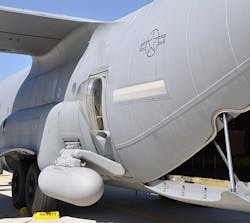Airdyne to provide Army SABIR bolt-on avionics mission modules to enhance C-130 aircraft capabilities
Officials of the Army Contracting Command at Aberdeen Proving Ground, Md., announced a $79 million contract to Airdyne last week for the Special Airborne Mission Installation and Response (SABIR) system.
SABIR is designed to transform the C-130 cargo aircraft into a platform for command, control, communications, computers, surveillance, and reconnaissance (C4ISR) without losing any capacity as a basic cargo aircraft.
SABIR's bolt-on avionics components enables users to change the C-130 in different ways to support various missions and aircraft configurations, and other requirements. Although SABIR is platform independent, the first SABIR system was designed for the C-130 four-engine turboprop aircraft.
A few SABIR components can increase crew visibility, for example, by adding the SABIR scanner door with its bulbous window to provide intersecting fields of view all around the aircraft, Airdyne officials say. SABIR does not interfere with loading, unloading, air drop, paratroop static line, or internal airlift and helicopter slingable container unit.
All SABIR components are operational whether the aircraft is pressurized or not. Airdyne engineers and fabricates pods to accommodate sensors, antennas, and electronic packages, including synthetic aperture radar; multi- and hyper-spectral imaging; high resolution day and night and thermal cameras; lidar; radar; chemical, biological, radiological and nuclear defense (CBRNE); and antenna arrays.
On this contract Airdyne will do the work at locations determined with each order. For more information contact Airdyne Aerospace online at http://airdyne.org, or the Army Contracting Command-Aberdeen at http://acc.army.mil/contractingcenters/acc-apg.
Ready to make a purchase? Search the Military & Aerospace Electronics Buyer's Guide for companies, new products, press releases, and videos
